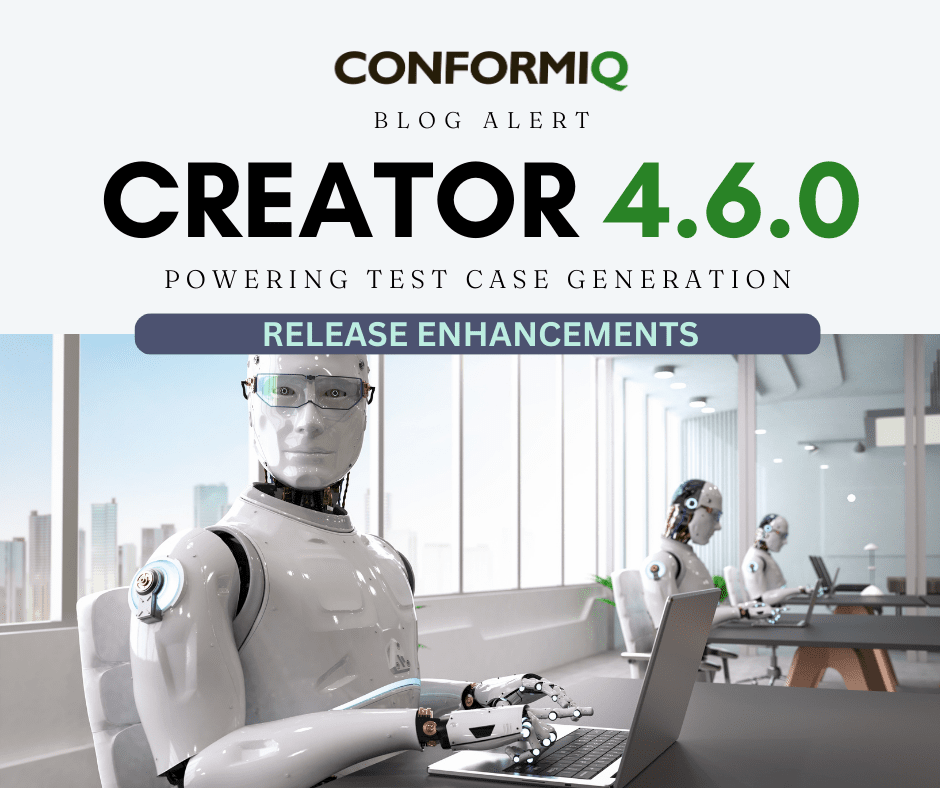Major Announcement – New Major Release Build out now!
INTRODUCTION
You may have been a domain specialist. Maybe, an intern just stepping into the world of Software Testing. But you are now a software test professional expected to move the test cycle along at a fast pace. And, one of the focus areas is to code for test cases and execute them automatically. You have learnt to capture the xpath of an object and want to learn the next steps. You know you have a Test Automation Centre of Excellence (TACoE) but also know that they cannot babysit you while you learn the trades of Automation Testing. It is all on you!
If your boss is a person responsible for running the show and making things happen, they would see their team struggling to complete all jobs at once. S/he may wonder if any “Scriptless Automation” tools can help you but may be confused with the answers google provides.
Need not worry anymore! ConformIQ brings to you Creator 4.6.0.
We have taken a very simplistic definition of “Scriptless Automation” – you generate scripts with a mouse click, and execute scripts with a mouse click. No coding is required on a test-case basis for day-to-day test execution. And, you do not need any other tools – except for Creator and your existing automation execution framework. Makes you feel good, isn’t it?
Let’s look at the different components required for “Automation Testing” and what we do about it:
- Scripts and other framework-related files: Yes, we do have code, but we generate that for you. You can use our default Scripters (basically, “Exporters”). If your organization has any specific requirements or even a custom framework, we can interact with your (TACoE) and develop a custom “Scripter”. This you can use in your daily life as a Tester to generate the scripts – in the language you need, in the format you need, in the file extension you need, or even export directly to an execution tool (like Tosca etc).
“Wait, is there no need for custom coding at all?”, you may ask. Yeah, that is true, there will be situations like that. But, which tool can handle all the scenarios of the world, right?
What we do is enable you to define your own piece of code. Or maybe, your TACoE has already done that for you and has a ‘Function Name’. Our layered architecture provides you with the ability to enter code in an easily comprehensible format – Microsoft Excel. And we read these lines or function names and reuse/call them as defined in the model. So, you get the big picture, right?
- Test Data: All the data entered into the model is exported as “test data” as per your framework datasheet. Sounds good?
- Object Locators: The third piece of the puzzle. Creator is a model-based testing tool. And capturing Object Locators requires interaction with SUT. “Surely, there is no way Object Locators are handled by Creator”, you may think. Enter Creator 4.6.0. Let’s talk about this in a little more detail.
With Creator 4.6.0, we have features to scan your target web page(s) – suffix intended – for page objects, not just for creating equivalent objects for our model (in files called “Structure Diagram”) but also to store the Object Locators. This information can also be exported into Object Repository file your framework may have. Going a step further, we can also export the Object Locator information into the scripts, eliminating the need to have an Object Repository file – which in most cases is cumbersome and confusing to use – and maintain its supporting functions.
Ultimately, you have your scripts and other framework files, test data and Object Locators information. So, go ahead and dump our output into your execution tool and click that “Run” button you always wanted to click!
During the course of SDLC, the scripts may start failing because of Object Locator changes. But you know how to capture xpath, right? Creator displays all objects in an organized and easily navigable UI. So, go ahead and identify the object, look up the properties and update the Object Locator information yourself. And, then few clicks to re-run the script.
Creating Structure Diagrams (for existing applications but where models need to be created) and identifying Object Locators (for automation execution) are 2 areas these features target, with potentially huge time and effort savings. Talk about killing 2 birds with one stone! However, if your larger team already uses Creator, I bet the models do not have Object Locator information inside them.
If you want to help them move to new ways of working – taking up more responsibilities but making work fun – don’t worry. We have migration utilities ready to read the existing Object Repository and import them to Creator.
Please watch the Demonstration Video to understand how we visualize the new testing landscape, the new normal. Also, scroll through the Release Announcement for more information.
Still any questions? Or, want to try out Creator 4.6.0? Reach out to us!
Happy testing!
You can download the new version release build Creator 4.6.0 only from → https://www.conformiq.com/extranet/myresources.php
To know more about the latest release build and how Creator can resolve your technical queries, reach us at – support@conformiq.com
For getting higher testing experience and to follow best practices for efficient testing with Creator, download the ‘Deployment Guidelines’ only from – https://www.conformiq.com/extranet/myresources.php
To learn more about Creator and other ConformIQ products, please visit our Linkedin and Youtube handles.
About The Author:
P Tejaswi Hebbar – Technical Director, ConformIQ
Tejaswi comes with over 16 years of Testing experience specializing in Test Automation space. He leads the product support within ConformIQ. He is a model-based testing enthusiast. His passion is contributing towards making the test lifecycle efficient and life of a tester fun. For any thoughts or more details, you can reach out to him @ support@conformiq.com

